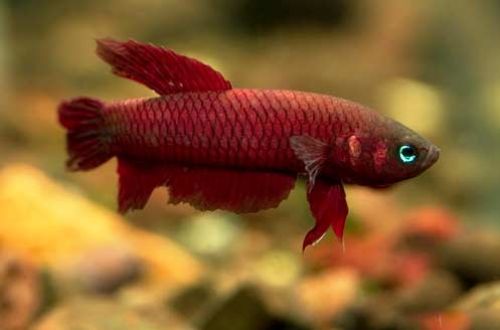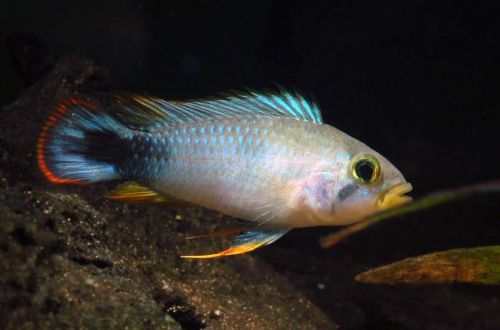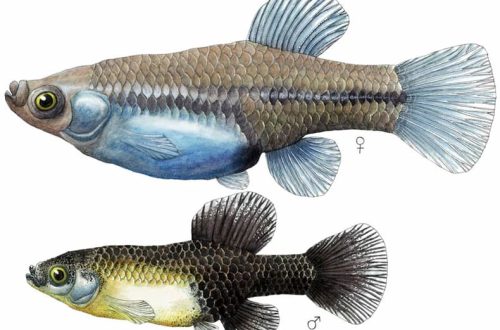
Cockerel Tussy
Fish Cockerel Tussy, scientific name Betta tussyae, belongs to the family Osphronemidae (Macropods). Named after a girl named Tussy Nagy, the wife of Australian aquarist Peter Nagy, who collected the first specimens of these fish and introduced them to the European public in 1979.

Contents
Habitat
The fish is native to Southeast Asia. It lives in peat bogs in the east of the Malay Peninsula in Malaysia. A typical biotope is a shallow body of water located in the depths of tropical forests with dense coastal vegetation. The lighting is dim due to the dense canopy of trees. The bottom of the reservoir is covered with a layer of fallen leaves, branches, snags, etc.
The water has a rich brown color due to the high concentration of tannins formed as a result of the decomposition of plant organic matter. The content of dissolved minerals is usually negligible, and the pH can be as low as 3.0–4.0.
Depending on the season of the year, there may be cases of the reservoir drying up in the place of which dirt remains mixed with plant residues. For some time, the fish are able to survive in such conditions in anticipation of rains.
Description
Adults reach a length of about 3 cm. Males are more colorful, painted in dark red colors. Females are gray with a pattern of two light broad stripes stretching from head to tail. The fins are translucent, may have a bluish tint.
Behavior and Compatibility
For such miniature fish, the same small species that can live in similar conditions should be selected as neighbors. For example, small cyprinids such as Rasboras, Kori catfish, some chars, etc.
Males compete with each other for the attention of females. In a small aquarium, it is recommended that only one male and one or more females be kept together. In spacious tanks with numerous hiding places, the presence of several males is acceptable.
Brief information:
- The volume of the aquarium – from 40 liters.
- Temperature – 22-27°C
- Value pH — 3.0–6.0
- Water hardness – 1–8 dGH
- Substrate type – any dark
- Lighting – subdued
- Brackish water – no
- Water movement – little or no
- The size of the fish is about 3 cm.
- Nutrition – any food rich in protein
- Temperament – peaceful
- Content – in a pair, a group of relatives and together with other species
Maintenance and care, arrangement of the aquarium
The optimal size of the aquarium for 2-3 fish starts from 40 liters. The design is selected at the discretion of the aquarist. Many breeders do not use substrates and decorations for ease of maintenance. However, Tussy Cockerel will look most natural in a setting that resembles his natural habitat. The main elements of decoration in this case will be: soft dark soil, natural snags, shade-loving plants, including floating ones, bark and dried tree leaves. The lighting is subdued.
For long-term maintenance, the composition of the water is of key importance. It is necessary to maintain acidic mild pH and GH values. The presence of dissolved tannins is welcome. They are added artificially with the help of purchased solutions in vials, or are released naturally during the decomposition of the leaves. For these purposes, you can use some trees growing in the middle lane, or purchase Indian almond leaves.
There must be no internal movement of water. The sources of flow in the aquarium are filters. In the case of the Petushki, a simple airlift filter is sufficient, which does not create excess flow, while providing sufficient efficiency for small tanks.
Food
In nature, they feed on small insects and zooplankton. The aquarium will accept popular dry food. Freeze-dried, fresh or frozen brine shrimp, bloodworms, daphnia, small or crushed gammarus, etc. will be a good choice.
Breeding and reproduction
Breeding is quite possible in the home aquarium if the fish are kept in suitable conditions and fed a balanced diet high in protein.
When the Bettas are ready to breed, the male chooses a place among the plants and prepares a nest on the surface from air bubbles. After a short courtship and mating dance, the fish create a clutch. The female swims away, and the male remains to defend the nest.
The incubation period lasts 1-2 days. The fry that have appeared remain in the nest for another 3–4 days until the yolk sac disappears. From this moment, the juveniles begin to swim freely in search of food, and the male leaves the protection of the masonry.
It is worth noting that adult Bettas usually do not eat their offspring. However, neighboring species may exhibit predatory instincts. For this reason, the fry should be transferred to a separate tank with identical water conditions. This will protect the juveniles and simplify the feeding process. The basis of the diet should be microscopic feed: specialized powders, suspensions. If possible – live ciliates, Artemia nauplii.
Sources: fishbase.mnhn.fr, wikipedia.org





